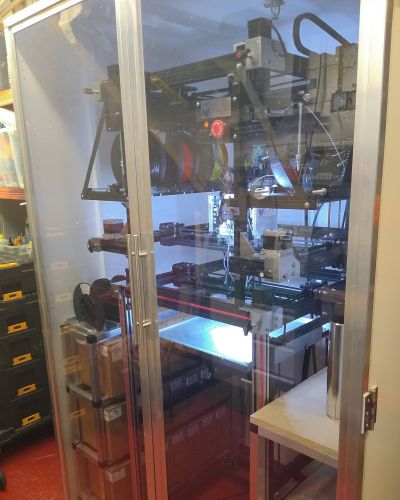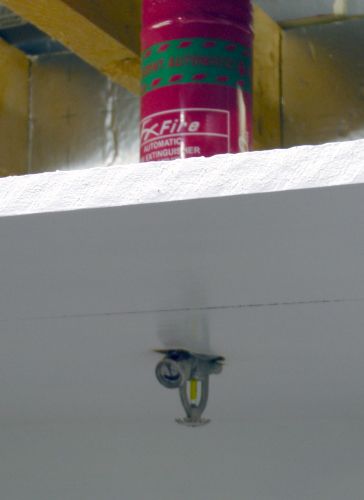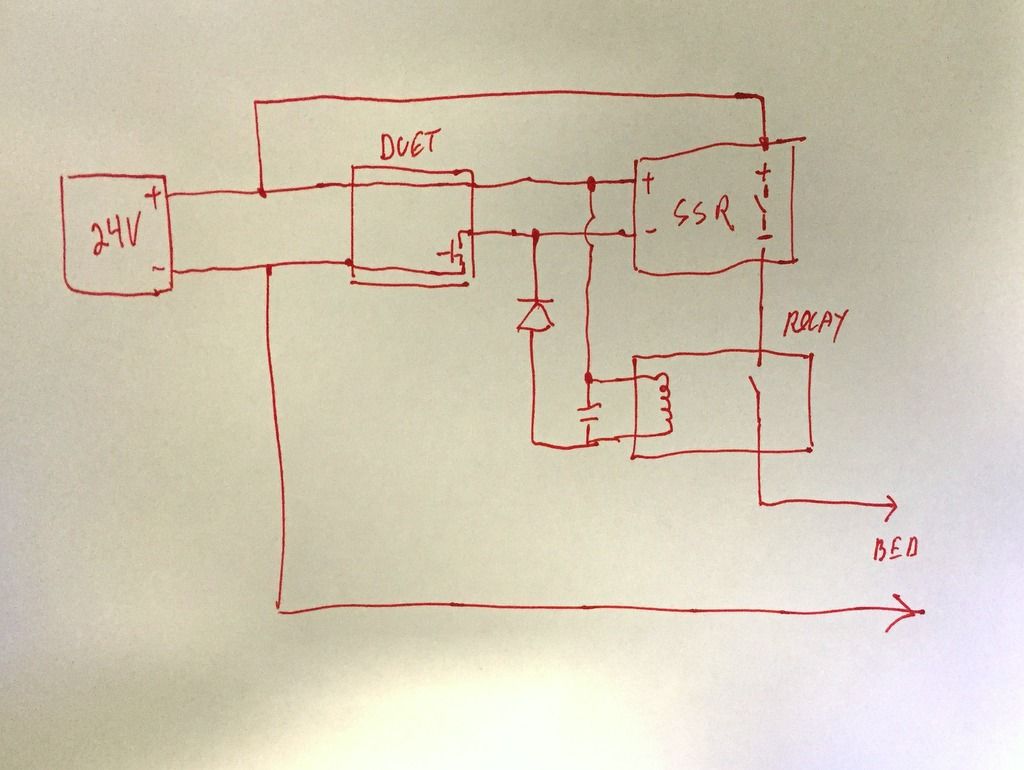Adding a 24V safety relay for the heaters, any thoughts?
-
@Danal On the subject of fire balls, my printer now has a new home

and in the top there is this

It's a clean agent fire extinguisher. That is to say, it floods the chamber with an inert gas - much kinder to sensitive electronics than powder.
More info here........
https://www.fireandsafetycentre.co.uk/advice-centre/clean-agent-extinguishers/ -
@infiniteloop said in Adding a 24V safety relay for the heaters, any thoughts?:
@deckingman said in Adding a 24V safety relay for the heaters, any thoughts?:
fitting a thermal fuse to a mains heated bed could in itself be construed as a safety hazard.
If you do not ground all metal parts in the neighbourhood of a mains powered device, you get all the risks on a silver tablet, even without the fuse.
Of course that's true - you must have missed my last sentence so I'll copy and paste it again - quote..........
"(To be clear, if you miss the smiley this wasn't intended as a serious post - just feeling a bit mischievous)."
-
@Danal said in Adding a 24V safety relay for the heaters, any thoughts?:
To be clear: Relays are useless, and possibly worse than useless, by given a false sense that they accomplish something.
Worthless comment without clarification or reference. They accomplish a very sound backup to cut power to a failed MOSFET as trusted by safety circuits in industrial equipment when complimented by diagnostic coverage, which can be covered to a degree by procedure.
They are as "useless" as seatbelts in a car. Tyres and brakes are great and avoid most serious injuries due to accidents - perhaps all of them for a life time of a driver - but most would accept the minor inconvenience of a belt regardless of it not completely removing all risk of serious injury or death.
-
On a second thought, maybe the mechanical relay can be added without using the PS_ON signal. Something along the lines of the diagram below. The mechanical relay closes the circuit as long as the duet sends PWM to the heated bed. Once the duet stops sending PWM, the circuit will break even if the SSR's mosfet get shorted (the duet's mosfet drives a small load so much less likely to get damaged).
Will this work?

-
@zapta said in Adding a 24V safety relay for the heaters, any thoughts?:
the circuit will break
the circuit may break, i.e. still a chance albeit much lower that the relay fails to open as well
-
@bearer said in Adding a 24V safety relay for the heaters, any thoughts?:
the circuit may break, i.e. still a chance albeit much lower that the relay fails to open as well
My assumption is that mechanical relay is good at not getting shorted and solid stay relay is good at fast PWM switching so this may achieve the good of both worlds.
-
@zapta said in Adding a 24V safety relay for the heaters, any thoughts?:
On a second thought, maybe the mechanical relay can be added without using the PS_ON signal. Something along the lines of the diagram below. The mechanical relay closes the circuit as long as the duet sends PWM to the heated bed. Once the duet stops sending PWM, the circuit will break even if the SSR's mosfet get shorted (the duet's mosfet drives a small load so much less likely to get damaged).
Will this work?

Looks to me like you basically duplicated the SSR function in the relay so that if either SSR or Relay fails, there is no power to the heat bed.
If you ae going to the trouble of a safety circuit then you might as well make it completely redundant by running the relay coil through a thermal fuse to the 24V power supply. As long as there is 24V and the fuse is ok, the bed has power that can be controlled by the SSR. In the event of an overheat situation, the fuse blows and the relay drops out.
Not sure why you have the diode in there and not a flyback diode. -
I don't understand the reluctance of using a thermal fuse for the bed. They are cheap and easy to use. If you are concerned with the reliability of a single fuse, put two in series.
Since thermal fuses generally are limited to 10A, using a relay helps to get the power rating up.None of this helps to guard against a printhead melt down but as mentioned before, you could mount a thermal fuse to the heatsink for some protection. Not sure how reliable that would be (you would need to figure out the maximum temperature that you would reach at the mounting location under normal use) but it would most certainly be better than no fuse.
-
relay contacts can still weld and effectively short like fet/ssr, but less common, and if you can avoid switching under load you greatly reduce the risk.
-
In the case of running the relay contacts off the 24V supply through a thermal fuse, you would never switch the contacts under load. The relay would activate when you power up the printer and stay active until you shut the printer off (unless the thermal fuse blows).
-
@jens55 "running the relay coil through a thermal fuse to the 24V power supply."
Yes, you are right, the thermal fuses fits well in this diagram since they don't have to handle the full bed current.
I plan to play a little with the PS_ON signal trying to understand it better. Will first use it to trigger a small 24 bulb so I can see when it's on and when it's off.
-
@zapta said in Adding a 24V safety relay for the heaters, any thoughts?:
@jens55 "running the relay coil through a thermal fuse to the 24V power supply."
Yes, you are right, the thermal fuses fits well in this diagram since they don't have to handle the full bed current.
I plan to play a little with the PS_ON signal trying to understand it better. Will first use it to trigger a small 24 bulb so I can see when it's on and when it's off.
Interesting that you mention a bulb .... I have a 100W 120V bulb permanently paralleled to my heat bed to let me know when it's powered up. It started as a 'temporary' thing but I really appreciate knowing what is happening.
-
Putting interlocks and checks on the coil side of the relay is the approach I used on a test system I built for a previous employer. It can reduce "diagnostic coverage" which is how much the system can be checked for correct opperation, but some of that can be covered with procedure. We're not needing a high performance level of the interlock compared to industrial systems such as robot cells where the probability of injury is far higher.
Risk of contact welding is significantly dropped by the use of suitably rated fuses to limit the current to well within the specification of the relay. Picking the relay to match the load is an obvious step amd thankfully inductive poad is minimal. Yes relays can fail shut but it isn't their common failure mode and relays are far more tollerant to transient spikes than MOSFETS.
Guided contact relays are expensive, but if the contacts on one pole weld shut the whole relay stays in the active position. You can use spare normally closed contacts to create a latch with a push button which effectively checks the relay each time you start the system.
-
Meltable heater fuses are common in all commercial products, why not use one for the bed? Normally they don't allow too much current to pass as they are intended to be used on mains so the heaters that run on mains can have the main heater wire just wired trough fuse, and if you are running a DC heater then it's required to either pass the main mains powering the printer trough this fuse or find thermal fuse with higher current capacity. You can easily find 10 and 15 Amp ones, that should be enough even for most DC powered beds.
e.g. Thermal Fuse 10A 250V 120˚C
or something like this https://www.digikey.com/product-detail/en/cantherm/SDF-DF144S/317-1135-ND/1014764
-
@Danal said in Adding a 24V safety relay for the heaters, any thoughts?:
(1) Trusting firmware for safety, if not designed from the very beginning around total shutdown driven by a hardware watchdog (charge pump, etc), is not safe.
..
To be clear: Relays are useless, and possibly worse than useless, by given a false sense that they accomplish something.In case of my 3D printer there is such a thing as 'good and unintrusive enough'. Quick incomplete analysis:
-
Bed heater stuck on full heat probably won't cause disaster; it is made out of aluminium, ceramic mat as insulation, silicone heater, supported on PTFE bushings and stainless steel screws. No real danger until the autoignition temperature of the plastic on top is reached and it is quite unlikely that the temperature rises that far given the limited power density of the heater.
-
Nozzle heaters stuck on full heat are worse, but only if they are buried in plastic. If they are free in the air, they bubble and boil plastic out, the last bits of plastic exit the nozzle in a fierce gaseous jet, and the silicone sock might turn dark brown and fall apart. But as long as the cooling loop keeps running no life threatening situation develops.
-
Motors are unlikely to burn, electronics are flame retardant enough and far away enough of flammable materials. Unlikely to cause a fire there.
Considering the above, being able to cope with a single point of failure and doing so preferrably before permanent damage is done is sufficient for me. This is something well within the capabilities of a mechanical relay and regular firmware. The remaining issue is that the Duet CPU currently is a single point of failure; if the processor decides to hang after the heaters and PS are turned ON there is no second mechanism left to act on that.
Regarding the AFO fireballs and similar solutions: I was about to buy a couple of them. But I asked two independant persons with a lot of knowledge and experience with firefighting before I did so. One had actually tested these fireballs, the other had no personal experience with them but knew what I was talking about. Both said independantly of each other 'Do not bother with them unless you really have to. It is better than nothing, but their their effectiveness is too low. If you want actual protection instead of a good feeling, use a sprinkler instead. Way cheaper also'.
-
-
@DaBit said in Adding a 24V safety relay for the heaters, any thoughts?:
use a sprinkler instead. Way cheaper also
Could you expand on that? It would seem a sprinkler requires a water supply, and it is hard to see how that is cheaper.
-
@DaBit said in Adding a 24V safety relay for the heaters, any thoughts?:
..................... It is better than nothing, but their their effectiveness is too low. If you want actual protection instead of a good feeling, use a sprinkler instead. '.
Better still, use a clean agent fire extinguisher as I mentioned above - much kinder to the electronics than water (or foam).
-
But nasty to people I guess? add ventilation or oxygen alam or no big deal?
-
@bearer Not sure about that TBH. I don't think they are desperately harmful - at lease there are no warning stickers to that effect. It is necessary to use a size which is appropriate to the volume of space in which it is enclosed but I think that's more to do with ability to put out a fire if the extinguisher was too small. The only thing I can add is to quote from the site that I linked too above which states "Typical applications include Boats, Computer Rooms, Clean rooms, switch rooms and telecomms, Data Storage Areas and art storage rooms."
-
.........bit more information here - https://blog.koorsen.com/a-comparison-of-the-three-most-common-fire-suppression-clean-agents-inert-novec-1230-and-fm-200 which indicates that clean agent systems are not a health risk in themselves - at least that's my take on it.
@zapta - apologies for going off at a tangent in your thread.